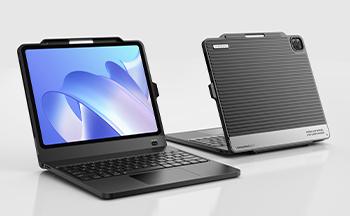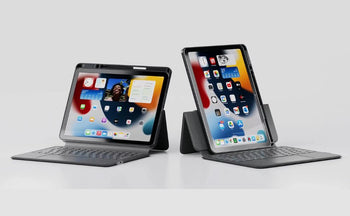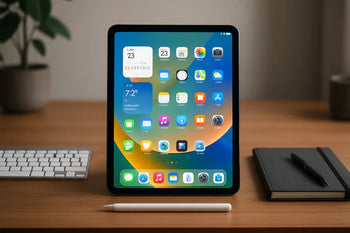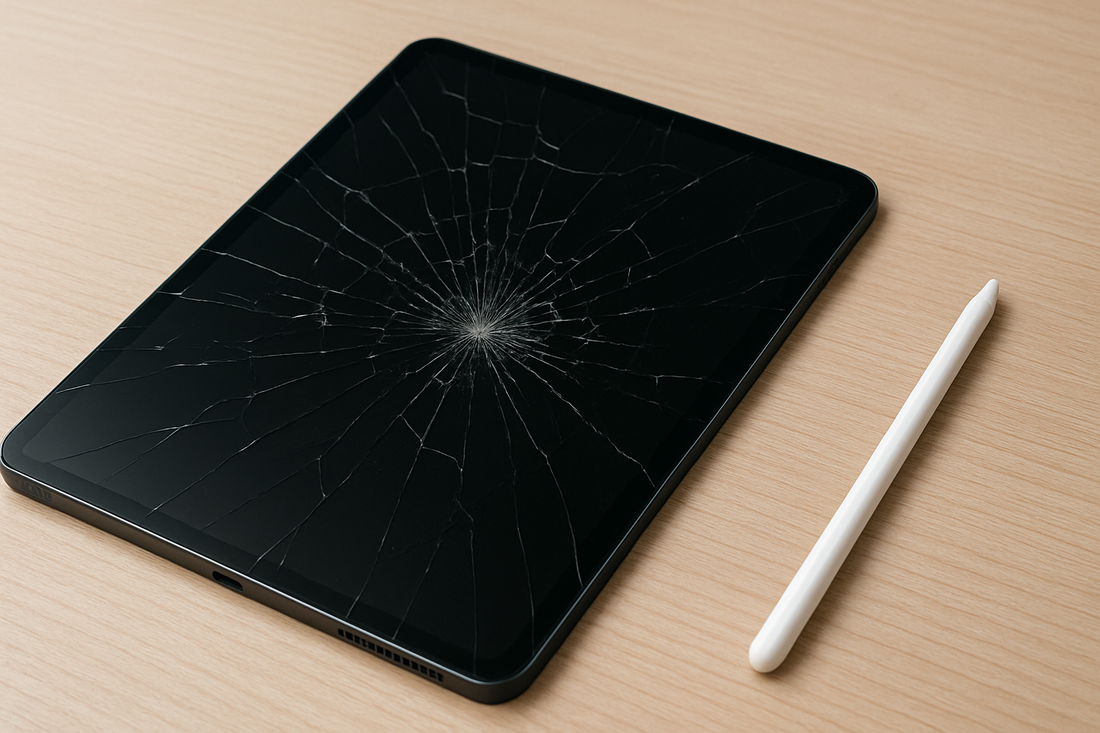An iPad broken screen is one of the most common issues users face, whether it’s a small crack or completely shattered glass. A damaged display not only makes your iPad harder to use but can also lead to further issues if left unchecked.
In this guide, we’ll cover how to assess the damage, what steps to take right away, and how to prevent future breaks with the right protection.
Keep your iPad safe from drops and scratches. Explore our heavy duty iPad cases built for maximum protection.
Assessing The Damage

Not all iPad screen damage is equal. The type of break, the display’s response, and whether the iPad still works will shape your next steps.
Cracked Glass Vs. Shattered Screen
A small crack in the glass can look alarming but often isn’t a dealbreaker. Many people continue using their iPads with minor surface cracks if everything else still works.
These cracks tend to spread over time, especially if the device is dropped or pressed. Shattered screens, though, are a different story—multiple fractures can create sharp edges and make the iPad unsafe.
Shattered glass also raises the risk of debris getting inside, which can harm internal parts. The difference between cracked and shattered screens matters because it affects repair urgency and cost.
|
Condition |
Risk Level |
Action Needed |
|
Small crack |
Low |
Monitor or repair |
|
Multiple cracks |
Medium |
Repair soon |
|
Shattered glass |
High |
Replace quickly |
Touchscreen Or Display Still Working?
The iPad screen has two main layers: the glass digitizer for touch and the LCD or OLED for the image. Sometimes, only one layer takes the hit.
If touch and display still work, chances are the damage is limited to the outer glass. Fixing that usually costs less.
But if the touchscreen lags, misses taps, or acts on its own, the digitizer may be damaged. Black spots, lines, or discoloration point to internal display trouble.
When these issues show up, just replacing the glass won’t solve it. Both layers might need replacement.
Signs You May Need Full Repair Or Replacement
Some screen damage goes beyond looks. If glass fragments fall out or the screen starts separating from the frame, it’s time for professional repair.
- Unresponsive buttons after the impact
- Battery swelling that pushes against the screen
- Backlight bleeding or flickering on the display
When several of these symptoms appear, a full screen assembly replacement is often necessary. On older iPads, repair costs can get close to what a replacement would be.
If you have warranty or device coverage, it’s worth checking if repair services are available. Sometimes, that’s the safest bet.
Need rugged protection for tough environments? Check out our iPad cases for industrial use designed for work in the field.
What To Do Right Away
Once the screen breaks, the iPad can still hold important files—and it can still hurt someone or get worse if you don’t act. Taking quick steps can reduce risks and keep things manageable until you get it fixed.
Back Up Your Data To Avoid Loss
A broken screen may still respond to touch, but cracks can spread and suddenly make the display unusable. Backing up your data now protects your photos, documents, and apps if the iPad stops working altogether.
- iCloud Backup: Connect to Wi-Fi, open Settings > [Name] > iCloud > iCloud Backup, and tap Back Up Now.
- Computer Backup: Use Finder on macOS or iTunes on Windows to save a full backup.
- External Storage: Some apps let you save files to external drives.
Try to finish the backup before trying any repairs or handling. That way, if the iPad stops responding, you’re not left without your data.
Avoid Cutting Your Fingers On Broken Glass
A cracked screen can leave behind sharp edges or loose fragments. Even a gentle swipe might cause a cut.
Don’t press directly on the damaged area. Handle the device carefully, and consider putting a piece of clear packing tape over the screen to hold the glass in place.
This makes it safer and keeps shards from falling out. If the damage is bad, using a stylus instead of fingers can help. Kids shouldn’t handle the iPad until the glass is secured.
Use A Temporary Case Or Protector Until Repair
Once the screen is cracked, the iPad becomes more vulnerable. Using a sturdy case or a temporary screen protector can help prevent further damage.
You can apply a plastic screen protector or even a sheet of clear adhesive film to cover the cracks. This keeps loose glass from spreading and adds a barrier against dirt and moisture.
A rugged case with raised edges can also help if the iPad gets dropped again before you get it fixed. These steps won’t repair the screen, but they’ll make the device safer and easier to use in the meantime.
Preventing Future Screen Breaks

Protecting your iPad comes down to using the right accessories, reducing impact risks, and paying attention to how you handle it each day. Even small steps—like adding a protective layer or storing it carefully—can save you from another repair.
Invest In A Durable Protective Case
A sturdy case absorbs shock if the iPad drops. Reinforced corners and raised edges shield the most fragile spots, like the screen and edges.
Materials such as silicone, TPU, or polycarbonate offer solid impact resistance without making the iPad too bulky. Some cases add stands or extra features, but durability should always come first.
Stylish, slim cases might look nice, but they usually protect less. For kids, a rugged case designed for heavy use is a good idea.
- Raised bezels keep the screen off flat surfaces
- Shock-absorbing layers reduce impact force
- Secure fit prevents the iPad from slipping out
Choosing a case with these features can really extend your device’s life and help you avoid repair costs.
Add A Screen Protector For Extra Safety
A screen protector gives your iPad’s glass a little extra defense. Tempered glass protectors stand out—they resist scratches and absorb impacts better than plastic films, and they don’t mess with clarity or touch sensitivity.
Plastic or film protectors are lighter and cheaper, but they don’t do much against cracks. They’re mostly for scratch protection. For most people, tempered glass is the way to go.
Installing a protector properly matters. Dust or air bubbles underneath can weaken its effect, so clean the screen first and align it carefully. Swapping out a worn protector every so often keeps your iPad safer in the long run.
Handle And Store Your iPad With Care
Even with a case and protector, how you handle the iPad makes a big difference. Dropping it on hard floors or stacking heavy stuff on top can still cause damage.
Carry the iPad in a padded sleeve or a dedicated compartment in your bag to reduce pressure and scratches. Don’t leave it in extreme heat or cold—high temps can weaken adhesives, and freezing weather makes glass brittle.
When you’re not using it, keep the iPad on a flat, clean surface. Simple habits—like carrying it with two hands or keeping it away from crowded spots—can help you avoid another cracked screen.
Prefer a slim but sturdy option? Discover our iPad hard cases for durable, everyday protection without the bulk.
Conclusion: iPad Broken Screen
A broken iPad screen can range from a minor crack to serious damage that affects daily use. Knowing how to assess the problem and take quick action helps protect both your device and your data.
The best long‑term solution is prevention. Using a durable case and screen protector greatly reduces the risk of future breaks and keeps your iPad safe on the go.
Want to learn more about protecting your device? Check out our guide on is your iPad waterproof to keep it safe from water damage too.
Frequently Asked Questions: iPad Broken Screen
Fixing a broken iPad screen depends on the damage, the repair method, and device coverage. Costs vary a lot, and ignoring the problem can lead to bigger headaches.
Can an iPad with a broken screen be fixed?
Yes, an iPad with a broken screen can be repaired. Apple and many independent shops offer this service. DIY kits exist but need special tools and may void your warranty.
How much does it cost to fix a whole iPad screen?
Costs vary by model and coverage. With AppleCare+ or protection, you’ll pay a smaller service fee. Without it, repairs usually range from $200 to $600.
Will a cracked iPad screen get worse?
Yes, cracks often spread over time. Drops, pressure, or even temperature changes make them worse. They can also affect touch response or let in dust and moisture.
Is it cheaper to repair or replace an iPad?
Repair is usually cheaper if only the screen is damaged. But for older iPads with multiple issues, replacement may be smarter. Compare repair costs with the device’s value to decide.


















